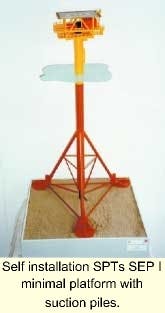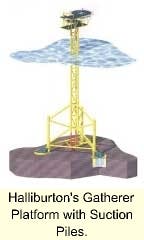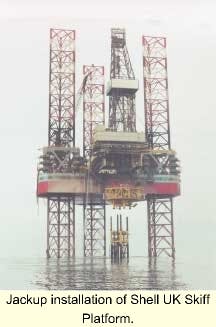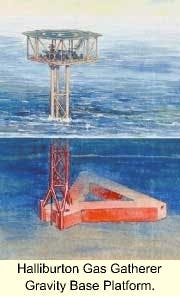MINIMAL PLATFORMS: Oil and gas prices, new concepts, technology renew interest in minimal facilities
High oil and gas prices are encouraging the independents and majors to take a fresh look at the technology and concepts required to develop marginal shallow water fields using a minimal platform approach. The continental shelf operating arena is changing. Many major oil companies are leaving the continental shelf or shifting their emphasis to deepwater and independent producers are filling the void.
The change has renewed interest in marginal fields in order to quickly capture the revenue from the high oil and gas prices. The economic incentives for the operators and a new wave of concepts by minimal platform designers are causing a renaissance in the technology and use of minimal platforms.
In exploring concepts, minimal platform designers and operators are looking at deck simplification, minimalization of environmental impact, low visit design, reusable solutions, alternative installation solutions, platform automation, and transfer of technology to deepwater.
Worldwide survey
The second worldwide survey of fixed minimal structures conducted by Mustang Engineering and Offshore Magazine identified 47 engineering companies and operators with approximately 150 minimal platforms or minimal deck designs. The results of this survey were compiled in a poster, which has been included in this issue of Offshore. The poster lists companies alphabetically, along with each design they are currently marketing. The intent of the survey and poster is to provide an objective look at the proven designs and concepts presently available to the industry.
The survey identified many new companies, new concepts, and new designs, which weren't listed in the initial survey. In order to help separate the concepts from the proven designs, each platform's water depth capability was identified for three water depth ranges: conceptual, detailed design and installed. The number of installations for each design, and contact information was also updated.
New technology
In a collaborative effort, Mustang Engineering, BP, and Granherne identified existing and future technology trends for minimal platforms:
- Suction pile technology: Suction pile platforms technology is becoming more accepted throughout the offshore industry. The platforms can be easily removed and engineered to be self-installing. To date, eight offshore oil and gas platforms have been installed using suction piles. Operators such as Statoil, Clyde Petroleum, Burlington, and Chevron used suction piles on their offshore platforms. Statoil was the first to use suction piles, beginning in 1989. Maersk Oil & Gas performed and published information about their research and engineering efforts for using suction buckets on their Wide Star minimal platform concept.
Among engineering companies, Suction Pile Technology of the Netherlands is the technology leader for using suction piles as a means to secure the platform to the seafloor. They are offering SIP I and SIP II designs to facilitate self-installation with the assistance of tugs, workboats, and barges.
Each year, more companies are offering suction piles as an alternative to a piled foundation for their design due to the recent successes. In the past four years, six of eight platforms were installed using suction piles.
Halliburton is now promoting this technology with their Suction Pile Gatherer design. Ocean Resources Ltd of Monmouthshire, UK is also offering this technology in their Sea Nova design. Mustang Engineering has performed preliminary engineering studies to incorporate suction piles on their Pegasus platform.
- Standardization: Repetitive use of a platform design reduces engineering costs and allows improvements to be incorporated in the next version. Engineering companies and operators have been focusing on standardization for years. For the non-cassion structures, Atlantia is the standardization leader with their Seahorse platform. To date, they have installed 70 platforms of the Seahorse design and 133 of their minimial platform series.
Tecnomare of Italy and operator Petrobel have worked together to standardize using Tecnomare's Monopode on five different projects offshore Egypt. Other companies, such as Halliburton, are pursuing a new standard design with their Gatherer series of platforms. To date, they have installed five Gatherers in the North Sea and offshore Australia, with an additional one under development.
The leader for deck standardization is State Service of Houston. The firm has developed a series of deck designs that are prefabricated and placed in inventory for rapid mobilization.
Many of the minimal platform designs, such as caissons, braced caissons, and monopods, have become commodity items because of the simplicity and repeatability of the design.
- Platform automation technology: Platforms are being simplified and automated to provide robust remote monitoring. They are achieving both unmanned status and reducing the number of platform visits and hence risk to personnel and operating costs. The high cost of operating manned facilities is providing an inducement for operators to make platforms NUIs (normally unmanned installations) by automation and simplicity. In the US Gulf, minimal platforms are simple installations, having only wellheads and limited process capability with low intervention costs.
In high cost areas, such as the North Sea, minimal platforms often incorporate some processing, which are typically manned facilities. The cost reduction initiatives of the North Sea region are providing the incentives to reduce operating costs by achieving unmanned status. The new challenge for operators is to identify and use emerging technology, such as fiber-optics and umbilical power, to eliminate the need for traditional manned installations such as compression and dehydration platforms.
- Deck minimization: Operators and engineering companies are increasingly focusing on deck minimization, due to the capital (capex) and operating (opex) cost benefits that can be achieved with minimal facilities. In capex terms, deck minimization not only reduces fabrication costs, but can potentially reduce installation costs by allowing the platform to be installed by a jackup, liftboat, or a smaller derrick barge.
Among the operators, BP and Shell have recently focused on deck minimization. Shell has taken a new approach to deck minimization on the Skiff development in the Southern North Sea by eliminating heliport access and by restricting boat access. BP has been working with engineering companies around the world to develop and refine their ideas on deck minimization on a project-by-project basis in areas as diverse as Trinidad, Azerbaijan and the North Sea.
Among the engineering companies, Atlantia, Halliburton, Kvaerner, and SLP Engineering, all are hotly pursuing ways to minimize the equipment, space, and weight on decks. These companies are looking at smaller and more compact equipment, as well as reducing functionality in order to eliminate equipment.
- Platform access technologies: The traditional means of access to an NUI has been by helicopter, but as platform inventory has diminished, transportation risk to personnel has become an increasingly significant factor. In harsh weather areas, such as the North Sea, the utility function associated with helicopter operation has driven up the deck size of minimal facilities, compared to the Gulf of Mexico. Operators such Shell Expro and Maersk Oil and Gas have moved to sea access systems using boat landings or leg ladders to transfer crew, based on the philosophy that the simpler decks have to be visited less frequently, even though they can only be accessed in low sea states.
A number of companies, such as Seascape Access Ltd, Oceantech, and Caley Ocean Sys-tems/Halliburton have developed patented sea access technologies, which allow visits by boat in similar operating limits to helicopter operations. More recently, Granherne worked with BP in harsh environments to develop helicopter accessed decks with challenged support facilities to achieve deck weights similar to the Gulf of Mexico.
- Power technologies: One of the outcomes of deck minimization is that power levels now required for unmanned operation are coming within the range of alternative power generation technologies, which promise substantial reduction in visit frequency over traditional gas engine or diesel generators. Robust gas burning power generation developed for remote location pipeline instrumentation in Arctic areas has been adopted for minimum platform applications by operators such as Apache, TotalFinaElf, and Agip.
These technologies include thermal electric generators or closed loop Rankine cycle turbines, delivering power in the 1-3kW range. Alternatively use of microturbines for the higher power range 20-50 kw (developed for the transportation industry) is currently being prototyped on BP minimum facilities.
- Green platforms: Operators are exploring the concept of "green" minimal platform, which reduced emissions or discharges. Operators such as BP, TotalFina Elf , Shell, and Apache are examining renewable power generation with battery bank backup from renewable sources such as wind, solar and wave energy to avoid emissions and reduce operating costs. In a further development, BP is taking the lead in developing shore-based electrification schemes to power offshore facilities and to reduce maintenance and offshore emissions. At the same time, BP is also looking at no flaring/vent operations and downhole disposal methods for drill cuttings and produced water.
- Reusable technology: The combined effect of increasing concerns about environmental impact, cost of abandonment, and the increasing trend among small developments to have field lives of five years or less is driving operators to develop reusable facilities for use in serial developments. Traditionally, re-use has required the recovery of the facilities to shore prior to relocation. However, a number of concepts have developed, which potentially allow the direct relocation of a facility from one location to another, using either self installing or jackup installed structures.
- Self-installation technology: Historically in the US Gulf, derrick barges and liftboats have been the primary choice for the installation vessel. Because of the bountiful availability of equipment in the Gulf, there has not been a need to seek out alternative installation techniques or methods. However, in other offshore regions of the world, alternate installation techniques are being developed and are being used to drive down installation costs.
Early generation designs, such as Sea Nova by Ocean Resource Ltd, used barges to aid installation, but new concepts such as SIP I are emerging. SIP I uses suction piles to aid installation as developed by Suction Pile Technology. Alternatively Arup Energy has developed self-installing lightweight gravity base structures, such as Drillace and Microace. All of these new concepts focus on reducing installation costs by eliminating the need for expensive installation equipment and have the ability to relocate with ease.
- Jackup installation technology: The desire for a low cost installation method and the potential for platform reuse is increasing the use of jackup rigs for installations worldwide. As the number of operators, engineering companies, and drilling contractors gain experience and confidence to use the jackup drilling rigs to install minimal platforms, the more this method becomes used and accepted.
In the North Sea, Shell UK Expro and Maersk Oil and Gas have used jackups to install minimal platforms. In 2000 Shell installed their Skiff platform based on the Trident design, using a jackup drilling rig. This approach greatly reduced the total installed facility cost and significantly improved the field economics. More recently, Maersk Oil & Gas and Suction Pile Technology/ Granherne developed the use of suction piles to significantly reduce the duration of jack-up installation windows caused by piling. The most active regions of the world using a jackup installation approach are offshore Australia and SE Asia, where due to remoteness, it is expensive to mobilize or demobilize derrick barges. Operators like Unocal, Apache and BHP used jack-up installations to provide a competitive alternative to derrick barge installations. Icon Engineering, a small engineering company based in Perth, Australia has been involved with at least 12 platform installations using jackups over the last eight years. The largest jackup installation was a 350te single piece tripod platform installed for BHP in the Buffalo field in 30m of water in the Timor Sea. At the same time, Halliburton successfully installed by jack-up, a three-piece GATHERER structure for the Apache Wonnich development in 1999.
Selection process
The wealth of minimal platform designs available to the industry for marginal field development can be confusing for any operator. Each operator must go through the process of selecting the best design for each project. Without knowing the full range of concepts and designs available, the operator limits selections and potential to reduce capex and opex.
Engineering companies are now offering a wealth and variety of concepts, which can help reduce the time to achieve a production stream as soon as possible. There is no need to re-invent the wheel when there are so many designs available. It is prudent for an operator to see what is available before going off to create a new design from scratch.
BP and Granhanere have created a minimal platform classification system in order to help BP's business units identify what type of minimal structure best suits the local economical and technical needs. This classification system will be discussed in an article appearing in the February issue of Offshore.
Author
E. Kurt Albaugh is a Sr. Consulting Engineer at Mustang Engineering, specializing in economic cost and feasibility studies for field development projects. He is also the Poster Editor and a Technical Advisor for Offshore Magazine. He was instrumental in publishing 25 different posters, and has authored or co-authored more than 25 technical papers or articles. He has 26 years of experience in the oil & gas industry. He holds a BSCE from Youngstown State University and a MCE from Rice University.
Pat O'Connor from the BP Houston Upstream Technology Group began his career with British Rail as a bridge designer prior to moving to the oil industry, where he has 24 years experience. His offshore career began in the North Sea where he worked for 4 years with engineering contractors prior to joining Amoco. His experience includes installation, engineering and project management roles on projects such as the Davy and Bessemer platforms in 1995, the first monopod facilities in the UKCS. From Houston, he now provides guidance to BP's global operations on structural/civil engineering issues and, in particular, minimum facilities design.
Bob Robinson is a business development manager with Granherne. He holds a doctorate in offshore wave energy structures. He has considerable experience in installation and structural engineering and field development planning for oil and gas projects over the last 18 years with Halliburton companies. His experience in project execution as jacket manager on several projects initiated his interest in minimum facility cost reduction and the development of the highly successful Gatherer design and the patented Sea Access wellhead.
Editor's Note: Offshore Magazine is organizing an International Minimal Platform Conference to be held in October, 2001. The two day conference will be held in Houston. Please contact Samantha Holloman, Event Manager for PennWell Petroleum Conferences for further information: Tel: (713) 621-9720; E-mail: samantha@PennWell.





